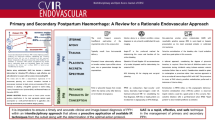Abstract
Purpose
Postpartum haemorrhage (PPH) is one of the main causes of maternal mortality and occurs in 5% of total deliveries. In this study we consider the indications for and technique and results of endovascular treatment for this serious event.
Materials and methods
Between January 2004 and December 2010, we conducted a nonrandomised prospective study on ten women with severe PPH who were treated endovascularly in an emergency setting. The procedure was considered to be clinically successful when the PPH resolved completely without the need for further surgical intervention. Laboratory values and the number of transfused blood packs were assessed for each patient.
Results
The endovascular procedure completely stopped the bleeding in 8/10 women. After embolisation, the remaining two patients underwent a second laparotomy, which completely arrested the bleeding. No patient died as a result of PPH, and no patient with PPH who avoided hysterectomy before endovascular treatment underwent it after the procedure.
Conclusions
In keeping with the literature, our study indicates that endovascular therapy can significantly help reduce the rates of hysterectomy and mortality due to PPH. This treatment, when performed in the angiography room, is safe and effective and is probably relatively uncommon and underused.
Riassunto
Obiettivo|L’emorragia post-partum (EP) si verifica nel 5% della totalità dei parti e rappresenta una delle principali cause di mortalità materna. In questo lavoro sono prese in considerazione indicazioni, tecnica e risultati del trattamento endovascolare di questa grave evenienza
Materiali e metodi
Nel periodo compreso tra gennaio 2004 e dicembre 2010 è stato condotto uno studio prospettico non randomizzato in cui 10 donne con diagnosi di EP severa sono state sottoposte a trattamento endovascolare in emergenza. Il successo clinico della procedura è stato definito come risoluzione della EP senza ricorso ad altri interventi chirurgici. Per ogni paziente sono stati valutati i valori laboratoristici ed il numero di sacche trasfuse.
Risultati
La procedura endovascolare ha ottenuto l’arresto completo del sanguinamento in 8/10 donne. Le 2 pazienti rimanenti, dopo l’embolizzazione sono state sottoposte a nuova laparotomia che ha determinato l’arresto completo del sanguinamento. Nessuna paziente è deceduta per EP e nessuna paziente con EP nonisterectomizzata prima è stata isterectomizzata dopo il trattamento endovascolare.
Conclusioni
La nostra esperienza e la revisione della letteratura evidenziano come il ricorso alla terapia endovascolare possa avere impatto significativo nella riduzione delle isterectomie e della mortalità per EP. Il trattamento in sala angiografica è sicuro, efficace e probabilmente poco diffuso e sotto-utilizzato.
Similar content being viewed by others
References/Bibliografia
AbouZahr C (2003) Global burden of maternal death and disability. Br Med Bull 67:1–11
CEMACH (2004) Why mothers die 2000–2002. Confidential enquiry into maternal and child health. RCOG Press, Royal College of Obstetricians and Gynaecologists, London
Knight M, Kurinczuk JJ, Spark P et al (2007) United Kingdom Obstetric Surveillance System (UKOSS) Annual Report. National Perinatal Epidemiology Unit, Oxford
Brace V, Kernaghan D, Penney G (2007) Learning from adverse clinical outcomes: major obstetric haemorrhage in Scotland, 2003–05. BJOG 114:1388–1396
Brown BJ, Heaston DK, Poulson AM et al (1979) Uncontrollable postpartum bleeding: a new approach to hemostasis through angiographic arterial embolization. Obstet Gynecol 54:361–365
Sergent F, Resch B, Verspyck E et al (2004) Intractable postpartum haemorrhages: where is the place of vascular ligations, emergency peripartum hysterectomy or arterial embolization. Gynecol Obstet Fertil 32:320–329
Greenwood LH, Glickman MG, Schwartz PE et al (1987) Obstetric and non malignant gynecologic bleeding: treatment with angiographic embolization. Radiology 164:155–159
Merland JJ, Houdart E, Herbreteau D et al (1996) Place of emergency arterial embolization in obstetric haemorrhage about 16 personal cases. Eur J Obstet Gynecol Reprod Biol 65:141–143
American College of Obstetricians and Gynecologists (ACOG) (2006) Practice bulletin no. 76: postpartum hemorrhage. Obstet Gynecol 108:1039
Condous GS, Arulkumaran S, Symonds I et al (2003) The “tamponade test” in the management of massive postpartum hemorrhage. Obstet Gynecol 101: 767–772
Japaraj RP, Raman S (2003) Sengstaken-Blakemore tube to control massive postpartum haemorrhage. Med J Malaysia 58:604–607
Seror J, Allouche C, Elhaik S (2005) Use of Sengstaken-Blakemore tube in massive postpartum hemorrhage: a series of 17 cases. Acta Obstet Gynecol Scand 84:660–664
Bakri YN, Amri A, Abdul Jabbar F (2001) Tamponade-balloon for obstetrical bleeding. Int J Gynaecol Obstet 74:139–142
Bakri YN, Linjawi T (1992) Angiographic embolization for control of pelvic genital tract hemorrhage: Report of 14 cases. Acta Obstet Gynecol Scand 71:17–21
Badawy SZ, Etman A, Singh M et al (2001) Uterine artery embolization: the role in obstetrics and gynecology. Clin Imaging 25:288–295
Vedantham S, Goodwin SG, Maclucas G et al (1997) Uterine artery embolization: an underused method of controlling pelvic hemorrhage. Am J Obstet Gynecol 176:938–948
Doumouchtsis SK, Papageorghiou A, Arulkumaran S (2007) Systematic review of conservative management of postpartum haemorrhage; what to do when medical treatment fails. Obstet Gynecol Surv 62:540–547
Healthcare Commission (2006) Investigation into 10 maternal deaths at, or following delivery at, Northwick Park Hospital, North West London Hospitals NHS Trust, between April 2002 and April 2005. UK Healthcare Commission, London
Author information
Authors and Affiliations
Corresponding author
Rights and permissions
About this article
Cite this article
Mansueto, G., Contro, A., Carbognin, G. et al. Endovascular treatment in postpartum haemorrhage. Radiol med 118, 215–228 (2013). https://doi.org/10.1007/s11547-012-0821-y
Received:
Accepted:
Published:
Issue Date:
DOI: https://doi.org/10.1007/s11547-012-0821-y



